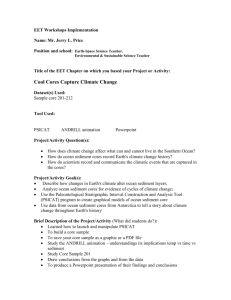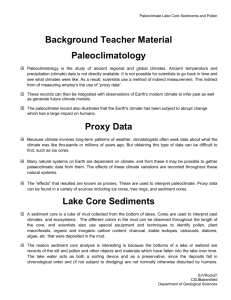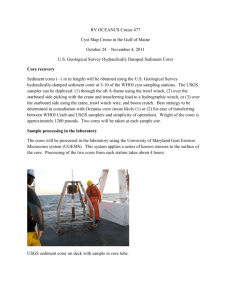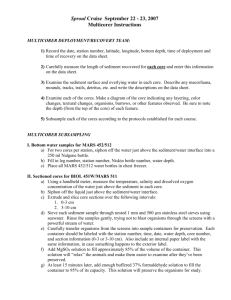GEO CPC
advertisement
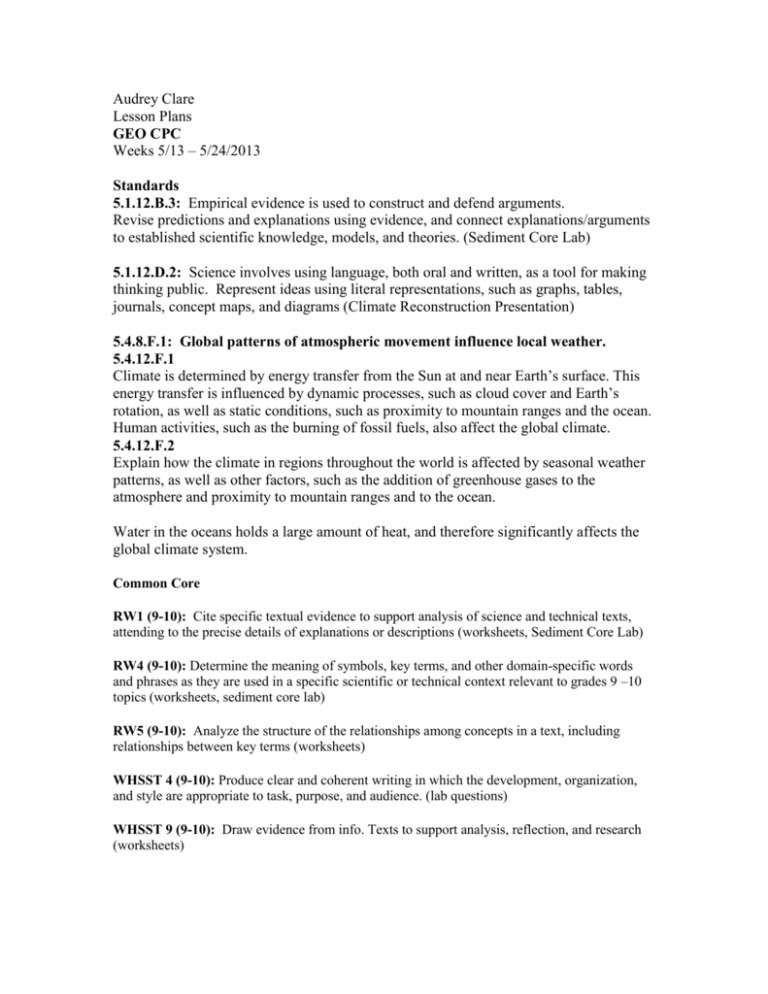
Audrey Clare Lesson Plans GEO CPC Weeks 5/13 – 5/24/2013 Standards 5.1.12.B.3: Empirical evidence is used to construct and defend arguments. Revise predictions and explanations using evidence, and connect explanations/arguments to established scientific knowledge, models, and theories. (Sediment Core Lab) 5.1.12.D.2: Science involves using language, both oral and written, as a tool for making thinking public. Represent ideas using literal representations, such as graphs, tables, journals, concept maps, and diagrams (Climate Reconstruction Presentation) 5.4.8.F.1: Global patterns of atmospheric movement influence local weather. 5.4.12.F.1 Climate is determined by energy transfer from the Sun at and near Earth’s surface. This energy transfer is influenced by dynamic processes, such as cloud cover and Earth’s rotation, as well as static conditions, such as proximity to mountain ranges and the ocean. Human activities, such as the burning of fossil fuels, also affect the global climate. 5.4.12.F.2 Explain how the climate in regions throughout the world is affected by seasonal weather patterns, as well as other factors, such as the addition of greenhouse gases to the atmosphere and proximity to mountain ranges and to the ocean. Water in the oceans holds a large amount of heat, and therefore significantly affects the global climate system. Common Core RW1 (9-10): Cite specific textual evidence to support analysis of science and technical texts, attending to the precise details of explanations or descriptions (worksheets, Sediment Core Lab) RW4 (9-10): Determine the meaning of symbols, key terms, and other domain-specific words and phrases as they are used in a specific scientific or technical context relevant to grades 9 –10 topics (worksheets, sediment core lab) RW5 (9-10): Analyze the structure of the relationships among concepts in a text, including relationships between key terms (worksheets) WHSST 4 (9-10): Produce clear and coherent writing in which the development, organization, and style are appropriate to task, purpose, and audience. (lab questions) WHSST 9 (9-10): Draw evidence from info. Texts to support analysis, reflection, and research (worksheets) Lesson Ch. 24.7: Climate Change – Warming Objectives: SWBAT explain cause of warming; identify evidence that Earth is warming; list possible negative impacts to warming Materials: PPT Procedure: Notes & discussion Assignment Sediment Core Lab (Data COLLECTION) Objectives: SWBAT … 1. Explain how sediment cores are used to study paleoclimate. 2. Make a key to identify pollen species 3. Use pollen in sediment cores to reconstruct climate history and identify the timing of glacial advances and retreats. Materials: PPT on sediment cores; video clip on sediment cores and ice cores from Antarctica; CORE lab (simulated cores and pollen) Procedure: 1. Video on cores and climate (INTRO); 2. Create a pollen identification key; 3. Make core observations; 4. Inventory pollen content for each layer of model sediment core; 5. Translate pollen counts to %s. Sediment Core Lab (Interpretation) Objectives: SWBAT determine patterns of warming and cooling using results and plant descriptions in pollen key. Materials: Results sheet Procedure: 1. Complete layer “R” together on summary sheet; 2. Students complete summary interpretation sheet. Lab Sediment Core Lab (Presentation) Objectives: SWBAT share/communicate climate reconstruction in folder-poster-presentation Objective: SWBAT … 1. Summarize climate interpretation in poster form. 2. Communicate interpretation in an interview (separate day) Carbon Cycle and Climate Change Objective: SWBAT … 1. identify processes that increase or decrease carbon dioxide. 2. Explain changes in greenhouse gases impact climate. Climate Test Review Objectives: SWBAT review and practice concepts in Ch. 24.7 Climate Materials: study guide; practice quiz Procedure: 1. Self quiz or station review w/ discussion Folder Poster Worksheet Week of 5/13 – 5/17 PERIOD Mon. D PERIOD 1 PERIOD 2 Ice Ages Tues A Wed B Thurs C Global Warming LAB: Sediment Cores & Climate (Data Collection) LAB: Sediment Cores & Climate (Data Collection & Interpretation) Ice Ages and Global Warming Global Warming LAB: Sediment Cores & Climate (Data Collection) LAB: Sediment Cores & Climate (Data Collection) PERIOD 8 PERIOD Ice Ages Global Warming LAB: Sediment Cores & Climate (Data Collection) Mon. A Tues B Fri D LAB: Sediment Cores & Climate (Data Collection) LAB: Sediment Cores & Climate (Data Interpretation) Thurs D Fri A Wed C PERIOD 1 LAB: SEDIMENT CORE & CLIMATE (Interpretation & Reporting) LAB: Presentation of Results Carbon Cycle and Climate Change x Review for Climate Test PERIOD 2 LAB: SEDIMENT CORE & CLIMATE (Interpretation & Reporting) LAB: Presentation of Results .x Carbon Cycle and Climate Change Review for Climate Test PERIOD 8 LAB: SEDIMENT CORE & CLIMATE (Interpretation & Reporting) x LAB: Presentation of Results Carbon Cycle and Climate Change Review for Climate Test Next Week: Climate Test and Ch.25: Solar System
